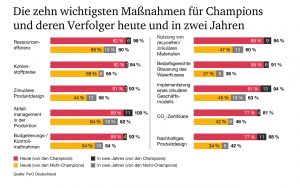ESG Study: High Ambitions, Low Drive

Only one-third of companies have implemented measures to reduce emissions to date.
Companies around the world are setting ambitious ESG targets, but only 6 percent are fully implementing the measures required to achieve them. More than half are still at a relatively early stage of ESG transformation, implementing only basic measures such as offsetting carbon emissions with carbon credits. These are the findings of the “ESG Empowered Value Chains 2025” study, for which PwC Germany surveyed more than 900 executives worldwide on the status quo of their ESG transformation.
The study suggests that many companies are struggling to implement measures, some of which are complicated and difficult to measure, such as redesigning products or improving diversity and inclusion. Meanwhile, a small group of advanced companies, which the study authors categorize as ESG champions, are working to incorporate ESG measures throughout their value chains to make themselves and their suppliers more sustainable and competitive.
ESG champions focus on speed, holism and transparency
The study shows that there has been a major shift in attitudes toward transformation to ESG-driven business operations as a driver of resilience and competitiveness. A small group of champion companies (6%) are making large investments under these auspices and foregoing short-term gains to make their businesses sustainable in the long term.
“ESG champions have similar characteristics,” explains Stefan Schrauf of PwC Germany. “They tend to be larger and have more than €3 billion in sales. They are better at making plans, backing them up with concrete actions and following them up over the long term.” ESG champions have detailed, short- and long-term roadmaps that cover most of their value chains. They also have a comprehensive overview regarding human rights risks in their value chains, as well as robust, product-specific standards for areas such as animal welfare or raw material sourcing.
ESG goals and KPIs linked to business objectives.
More than 70 percent of the ESG Champions’ products and services are in line with ESG objectives. They have ESG targets and KPIs that are linked to business objectives, broken down to operational functions, and subject to regular monitoring. Eighty-one percent of champions are significantly realigning their business models, for example by moving to circular business models or aligning their product portfolio with ESG goals. By comparison, only 15 percent of other companies do this.
ESG champions are also further ahead in digitization and have higher levels of data transparency and accessibility. 81 percent say their ESG data is fully available and used for decision-making. By comparison, only 13 percent of companies away from the champions claim this.

Advanced digitization accelerates sustainable transformation
Most companies say that inadequate IT infrastructures, a lack of digital solutions, and limited data access are among their top ESG challenges. Since many companies’ digital capabilities are still evolving, these findings are hardly surprising. For example, recent PwC research showed that 64 percent of industrial manufacturing companies are still in the early stages of digital transformation.
The study illustrates that a high level of digitalization is essential for the implementation of ESG measures – especially when it comes to the data required for this purpose. This must be reliable and accessible everywhere in the company in order to be able to effectively monitor, track and control impacts and activities. Here, pioneers typically rely on modern IoT solutions to measure environmental KPIs in real time and determine the environmental footprint of entire factories as well as individual machines and products.
In addition, analytics can help predict energy consumption. Technology is also key to ESG-focused collaboration with suppliers and customers across the entire value chain and essential to meeting growing reporting requirements. As a result, gaps in digitization quickly lead to lagging behind the competition.